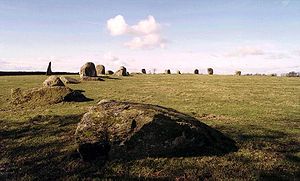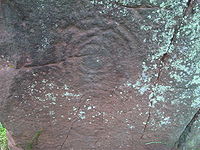
Long Meg and Her Daughters
Encyclopedia

may2005.jpg)

Bronze Age
The Bronze Age is a period characterized by the use of copper and its alloy bronze as the chief hard materials in the manufacture of some implements and weapons. Chronologically, it stands between the Stone Age and Iron Age...
stone circle
Stone circle
A stone circle is a monument of standing stones arranged in a circle. Such monuments have been constructed across the world throughout history for many different reasons....
near Penrith
Penrith, Cumbria
Penrith was an urban district between 1894 and 1974, when it was merged into Eden District.The authority's area was coterminous with the civil parish of Penrith although when the council was abolished Penrith became an unparished area....
in Cumbria
Cumbria
Cumbria , is a non-metropolitan county in North West England. The county and Cumbria County Council, its local authority, came into existence in 1974 after the passage of the Local Government Act 1972. Cumbria's largest settlement and county town is Carlisle. It consists of six districts, and in...
, North West England
North West England
North West England, informally known as The North West, is one of the nine official regions of England.North West England had a 2006 estimated population of 6,853,201 the third most populated region after London and the South East...
. One of around 1,300 stone circles in the British Isles and Brittany
Stone circles in the British Isles and Brittany
The stone circles in the British Isles and Brittany were constructed as a part of a megalithic tradition that lasted from 3,300 to 900 BCE, during the Late Neolithic and Early Bronze Age...
, it was constructed as a part of a megalith
Megalith
A megalith is a large stone that has been used to construct a structure or monument, either alone or together with other stones. Megalithic describes structures made of such large stones, utilizing an interlocking system without the use of mortar or cement.The word 'megalith' comes from the Ancient...
ic tradition that lasted from 3,300 to 900 BCE, during the Late Neolithic and Early Bronze Age.
The stone circle is the sixth-biggest example known from this part of north-western Europe, being slightly smaller than the rings at Stanton Drew
Stanton Drew
Stanton Drew is a small village and civil parish within the Chew Valley in Somerset, England, situated north of the Mendip Hills, south of Bristol in the Bath and North East Somerset Unitary Authority....
in Somerset, the Ring of Brodgar
Ring of Brodgar
The Ring of Brodgar is a Neolithic henge and stone circle on the Mainland, the largest island in Orkney, Scotland...
in Orkney and Newgrange
Newgrange
Newgrange is a prehistoric monument located in County Meath, on the eastern side of Ireland, about one kilometre north of the River Boyne. It was built around 3200 BC , during the Neolithic period...
in County Meath.
It primarily consists of 51 stones (of which 27 remain upright) set in an oval shape measuring 100 m on its long axis. There may originally have been as many as 70 stones. Long Meg herself is a 3.6 m high monolith of red sandstone
Sandstone
Sandstone is a sedimentary rock composed mainly of sand-sized minerals or rock grains.Most sandstone is composed of quartz and/or feldspar because these are the most common minerals in the Earth's crust. Like sand, sandstone may be any colour, but the most common colours are tan, brown, yellow,...
18 m to the southwest of the circle made by her Daughters. Long Meg is marked with examples of megalithic art
Megalithic art
Megalithic art refers to the use of large stones as an artistic medium. Although some modern artists and sculptors make use of large stones in their work, the term is more generally used to describe art carved onto megaliths in prehistoric Europe....
including a cup and ring mark
Cup and ring mark
Cup and ring marks or cup marks are a form of prehistoric art found mainly in Atlantic Europe and Mediterranean Europe although similar forms are also found throughout the world including Mexico, Brazil, Greece, and India, where...
, a spiral and rings of concentric circles.
Aerial photography has identified several undated enclosures in the area and the smaller stone circle of Little Meg
Little Meg
Little Meg is a small circle of large kerb stones which probably surrounded a Bronze Age kerb cairn. It is close to the village of Langwathby to the north-east of Penrith in the English county of Cumbria and is 640 meters north-east of the more famous stone circle of Long Meg and Her Daughters.One...
is close nearby.
Folklore
The most famous of the many legends that surround the stones is that they were once a covenCoven
A coven or covan is a name used to describe a gathering of witches or in some cases vampires. Due to the word's association with witches, a gathering of Wiccans, followers of the witchcraft-based neopagan religion of Wicca, is also described as a coven....
of witches who were turned to stone by a wizard from Scotland
Scotland
Scotland is a country that is part of the United Kingdom. Occupying the northern third of the island of Great Britain, it shares a border with England to the south and is bounded by the North Sea to the east, the Atlantic Ocean to the north and west, and the North Channel and Irish Sea to the...
named Michael Scot
Michael Scot
Michael Scot was a medieval mathematician and scholar.- Early life and education :He was born in Scotland, and studied first at the cathedral school of Durham and then at Oxford and Paris, devoting himself to philosophy, mathematics, and astrology...
. It is said the stones cannot be counted - but, if anyone is able to count them twice and come to the same total - the spell will be broken or it will bring very bad luck. Another legend states that if you walk round the circles and count the number of stones correctly, then put your ear to Long Meg, you will hear her whisper. The name itself is said to come from a local witch, Meg of Meldon, who was alive in the early 17th century.
Academic Books
|first= |authorlink=Aubrey Burl |year=2000 |publisher=Yale University Press |location=New Haven and London |isbn=978-0300083477 |ref=Bur00}} |first= |authorlink=Aubrey Burl |year=2005 |publisher=Yale University Press |location=New Haven and London |isbn= |ref=Bur05}} |first= |authorlink=Richard Bradley |year=1998 |publisher=Routledge |location=London |isbn=978-0415152044 |ref=Bra98}} |first= |authorlink= |year=1985 |publisher=Phillimore |location=Chichester |isbn=|ref=Wat85}}- Samuel Pyeatt Menefee, "Meg and Her Daughters: Some Traces of Goddess Beliefs in Megalithic Folklore," in Sandra Billington and Miranda Green eds., The Concept of the Goddess (1996): pp. 78–90.

